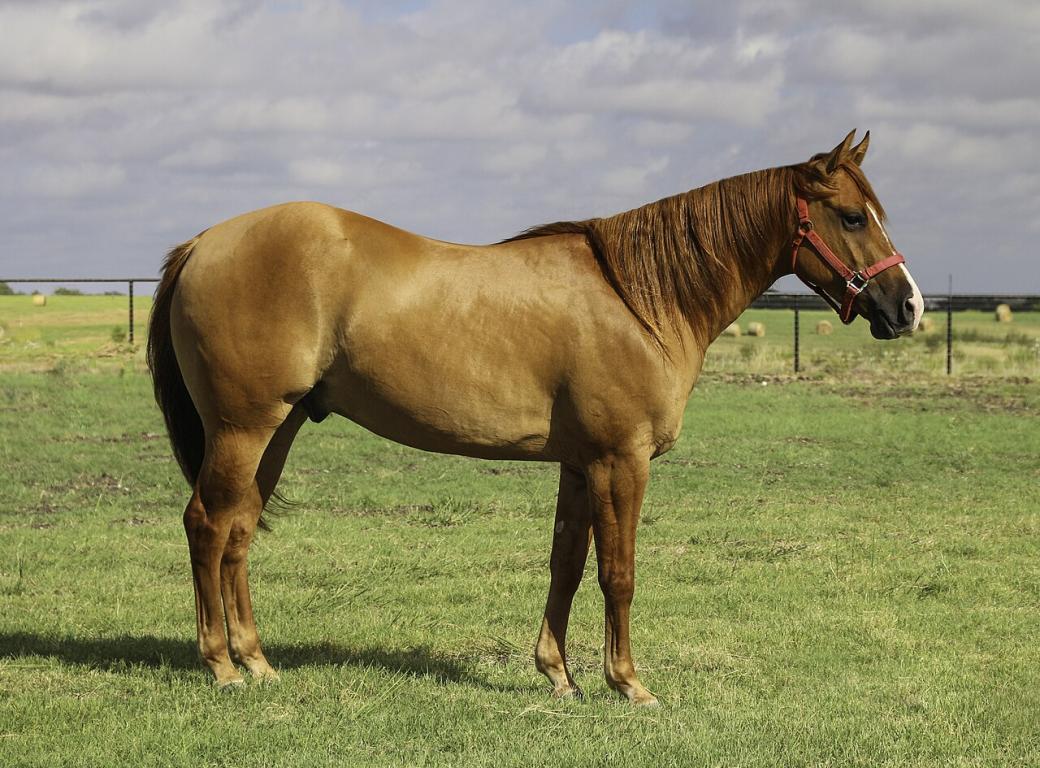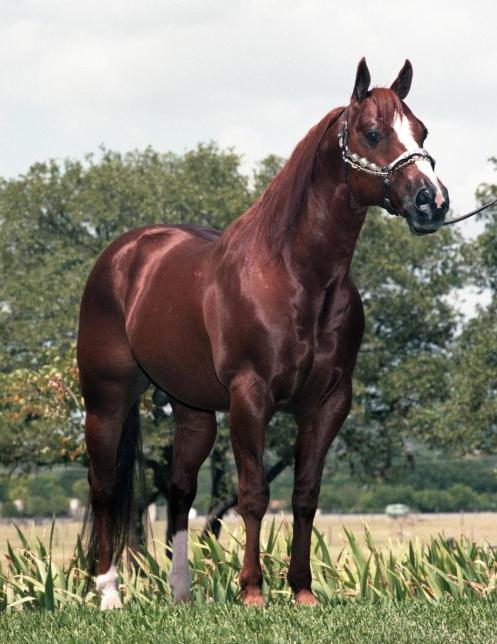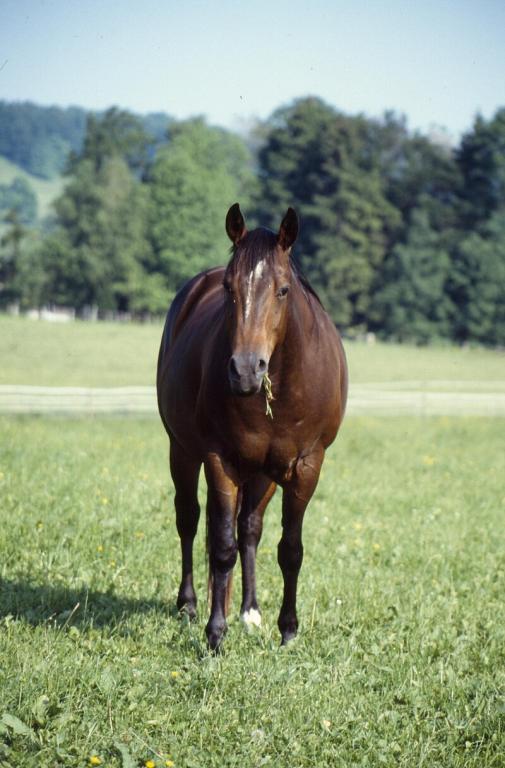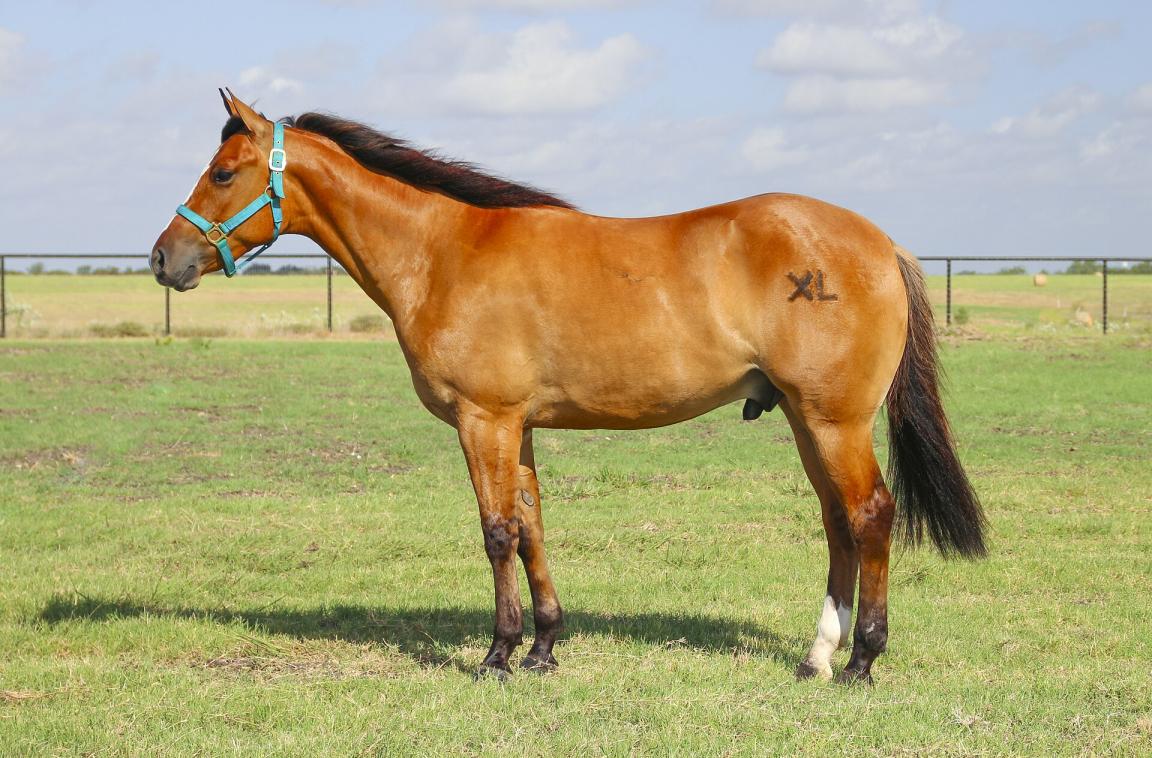
Continent: America
Country: United States
Weight: 430 – 545 kg
Height: 142 – 163 cm



The Quarter Horse is a breed originating from the United States, regarded as the first truly American horse breed. Its name comes from its exceptional ability to sprint a quarter mile (about 400 meters) faster than any other horse, making it a highly popular racehorse in the American colonies for many years.
The origins of the Quarter Horse date back to the 17th century, following the crossbreeding of:
-imported English horses (notably Thoroughbreds),
-with Iberian and Chickasaw horses already present on American soil, themselves descendants of the Spanish horses brought to the New World.
This blend gave rise to a compact, fast, heavily muscled horse with a natural instinct for cattle. Over time, the Quarter Horse became the ultimate working horse on Western ranches, particularly valued for cattle sorting, rodeo sports, and long days spent riding across the plains.
Today, the Quarter Horse is the most popular horse breed in the world by number of registrations and stands as a living icon of American Western culture.
The Quarter Horse is primarily bred in the United States, its country of origin. The main breeding centers are located in the southern and western states, notably:
-Texas (home to the largest number of registered horses),
-Oklahoma,
-Colorado,
-Arizona,
-Montana,
-and Nevada.
These regions, historically tied to cattle ranching and western riding, provide an ideal environment for the development of the breed.
Outside the U.S., the Quarter Horse is also widely bred in Canada, Brazil, Argentina, Australia, and several European countries (notably France,
Germany, Italy, and the Netherlands), where it is experiencing steady growth thanks to the rising popularity of western disciplines.
In all these countries, it is bred for competition, leisure, and sometimes for crossbreeding with other horses to enhance versatility and temperament.
The Quarter Horse holds significant genetic value due to its highly versatile physical and behavioral traits. It is known for passing on:
-excellent muscular development, especially in the hindquarters,
-exceptional responsiveness, highly valuable in cattle work and western disciplines,
-and a balanced temperament, both willing and cooperative.
Its bloodlines are widely used to enhance other breeds or horse types oriented toward:
-utility work (ranching, cattle handling),
-western sports (reining, cutting, barrel racing),
-and even leisure riding, thanks to its reliability and comfort.
The breed has also served as a foundation for the creation of specialized types, such as:
-the racing Quarter Horse, crossed with Thoroughbreds for speed,
-and the ranch Quarter Horse, selected for toughness and stamina.
Finally, the Quarter Horse contributes to the preservation of valuable genetic lines within breeding programs focused on hardiness, mental balance, and adaptability.
Colonial Origins (16th–17th Centuries):
The Quarter Horse is considered the oldest horse breed developed on American soil. It originated from crosses between Spanish and English horses, initiated in the early 17th century by European settlers along the East Coast of what would become the United States.
-Spanish horses: Descendants of the Barb, introduced as early as the 16th century by conquistadors. These horses gave rise to indigenous populations such as the Chickasaw, which had a major influence on the breed.
-English horses: First imported to Jamestown (Virginia) around 1610–1620, mainly Hobbies and Galloways, small, sturdy, and fast horses.
-Other influences: The Canadian horse, the Morgan, and later a few selected Thoroughbreds.
As early as 1611, these bloodlines were crossed, producing compact, agile, explosive horses valued by settlers for short-distance sprint races and everyday transportation.
The Short-Racing Era (18th Century):
By the 1690s, colonists developed a passion for quarter-mile races (roughly 400 meters), held in streets, fields, and villages. These popular races gave rise to the early Quarter-Pathers or Short Horses, the direct ancestors of today’s Quarter Horse.
-These horses regularly outpaced Thoroughbreds over short distances, despite their rustic appearance.
-The stallion Janus, a Thoroughbred imported in 1752, was one of the few to leave a lasting mark on the breed by transmitting speed and a powerful hindquarter.
Westward Expansion and Working Horse Evolution (19th Century):
In the 19th century, long-distance racing trends favored the Thoroughbred, pushing the Quarter Horse toward more utilitarian roles. However, the breed found a new purpose with westward expansion:
-Used in farming, logging, the Civil War, and especially cattle work, the Quarter Horse became the cowboy’s horse.
-Renowned for its cattle sense, maneuverability, and stamina, it proved essential on large ranches.
-Major ranches, such as Captain King’s ranch in Texas, developed specific bloodlines, sometimes with no Thoroughbred influence at all.
During this period, key stallions like Steel Dust (born in 1843) and his grandson Billy became legends. Their offspring were known as Steel Dust Horses.
Official Recognition (20th Century):
By the 1920s, breeders called for the official recognition of this unique lineage. The movement culminated in 1940 with the creation of the American Quarter Horse Association (AQHA) in Fort Worth, Texas.
-The stallion Wimpy, grandson of Old Sorrel, was given number 1 in the AQHA stud book.
-The AQHA established breed standards: compact build, explosiveness, intelligence, and versatility.
-The breed became extremely popular in the Southwestern U.S., symbolizing the ideal ranch horse.
Global Expansion (Since 1960):
From the 1960s onward, the Quarter Horse began to spread beyond U.S. borders, thriving in leisure riding, competition, and cattle breeding.
-The AQHA initiated partnerships in Latin America, Australia, Europe, Japan, and more.
-By 1983, AQHA had official affiliates in ten major importing countries.
-By 2003, over 4 million Quarter Horses were registered worldwide.
At the same time, the breed became a symbol of Western riding culture, contributing to the growth of natural horsemanship and Western equestrian sports globally.
The Quarter Horse is renowned for its balanced temperament, sharp intelligence, and exceptional agility. Historically bred for tasks requiring calmness, reactivity, and mental endurance, it blends the best qualities of a working ranch horse with those of a modern performance competitor.
-Highly versatile, the breed easily adapts to a wide range of riders and disciplines. Its cooperative nature makes it a top choice for both beginners and professionals.
-It is generally docile, patient, and reliable, especially in working environments. These traits make it a favorite in riding schools and leisure centers.
-At the same time, the Quarter Horse shows keen awareness, quick learning, and a well-developed instinct, particularly in cattle-related sports like cutting or reining.
-However, it remains sensitive to the rider’s hands and cues, and may become either dull or overly reactive if subject to inappropriate or repetitive stimulation. Its adaptability can sometimes mask specific mental and physical needs.
Finally, the breed maintains a strong bond with humans, rooted in its history as a daily working partner on ranches. Many owners report a deep relationship of trust with their Quarter Horse, which can be protective, affectionate, and highly attached to its rider.
The Quarter Horse has strong prospects for the future on a global scale. Its exceptional versatility, docile temperament, and athletic abilities make it a highly sought-after breed, both for high-level competition and leisure riding.
In the United States, breeding is closely overseen by the AQHA (American Quarter Horse Association), which continues to implement rigorous selection programs and promote the breed internationally. The growth of disciplines such as reining, cutting, barrel racing, and ranch riding strongly contributes to the breed’s expansion in professional circuits.
In Europe and Latin America, interest in the Quarter Horse continues to rise, especially thanks to the spread of western riding sports and the development of new specialized breeding programs.
However, emerging challenges include maintaining genetic diversity, as some highly performing lines show signs of inbreeding risks. This raises the need for a sustainable approach to managing the breed, ensuring the preservation of its morphological diversity and the balanced temperament that historically define the Quarter Horse.
The Quarter Horse is generally considered a hardy and resilient breed, thanks to its origins as a working horse in American ranches. It enjoys good functional longevity, with most individuals exhibiting a solid constitution and a stable immune system. However, the specialization of certain bloodlines has led to the emergence of some notable hereditary predispositions.
-HYPP (Hyperkalemic Periodic Paralysis)
A genetic neuromuscular disorder primarily affecting lines descended from the stallion Impressive. Symptoms include muscle tremors, stiffness, and even sudden paralysis. Genetic testing is mandatory in many international studbooks for horses carrying the gene (H/H or N/H).
-HERDA (Hereditary Equine Regional Dermal Asthenia)
A connective tissue disorder that causes fragile skin, which may tear easily — especially prevalent in cutting horse lines. It is fatal in the long term. Today, genetic screening is widely practiced among breeding stock from carrier lines.
-PSSM1 (Polysaccharide Storage Myopathy type 1)
A muscle metabolism disorder causing stiffness, pain, and difficulty in movement. It can be managed through a strict diet (low in starch) and regular exercise. Some Quarter Horse lines are more susceptible than others.
-GBED (Glycogen Branching Enzyme Deficiency)
A severe and usually fatal metabolic disorder in foals, which impairs proper glycogen storage in muscles and liver. Prevention relies entirely on genetic testing of breeding animals.
-MH (Malignant Hyperthermia)
A rare but serious disorder causing sudden acute hyperthermia, typically triggered by stress or anesthesia. Testing is recommended for some performance-oriented lines.
Aside from these well-documented hereditary conditions, the Quarter Horse is known for:
-Natural weather resistance (especially in ranch-type or rustic lines),
-Good recovery after exertion,
-A generally harmonious growth, although early-maturing sport lines may require special attention to joint health.
As with any highly popular modern breed, careful selection of breeding stock is essential to preserve genetic quality and prevent issues related to inbreeding or extreme specialization (e.g., halter, racing lines).
An intermediate gait between a fast walk and a trot, typical of Western riding. The jog is short, rhythmic, very smooth and with little bounce, making it particularly comfortable for the rider. It is a two-beat diagonal gait like the classical trot, but with reduced impulsion and high regularity. Often used in Western Pleasure or ranch work.
A slow, collected three-beat canter with great relaxation. The lope is usually low in energy, smooth, and close to the ground. It is a hallmark gait in Western Pleasure, reining, or ranch riding.
A more energetic jog used to show reach and stride length while maintaining the regularity and softness of the jog. Requires more propulsion, especially in ranch riding or in transitions during Western show patterns.
A faster, more extended version of the lope, closer to a regular canter but still controlled and relaxed. Demonstrates power and engagement, especially in ranch horse classes to show the horse’s physical conditioning.
A very fast pivot on the hindquarters, executed in a tight circle. Used in reining, the spin requires great responsiveness and precision from the horse.
A sudden, gliding stop from a lope. Very spectacular, it demonstrates training, obedience, and the horse’s ability to stay balanced at high speed. Typical of reining events.
Born on 01/01/1937
First officially registered Quarter Horse in the AQHA studbook (registration number 1). Son of stallion Solis and grandson of Old Sorrel, he became one of the breed’s genetic cornerstones. Winner of the first AQHA show in 1941.
Born on 01/01/1956
Founding sire of modern cutting and reining bloodlines. Initially bred for racing but became a benchmark for athleticism, agility, and intelligence in his descendants.
Born on 01/01/1969
One of the most influential sires in the halter horse category. Famous for his exceptional musculature, but also notorious for having passed on the HYPP gene to thousands of offspring.
Born on 01/01/1981
Multiple AQHA titles in both western and hunter disciplines, including the prestigious AQHA Superhorse title. Known for his elegance, intelligence, and unmatched versatility.
Born on 01/01/1979
Triple winner of the Cutting Triple Crown (NCHA Futurity, Super Stakes, and Derby). Sire of offspring earning over $30 million in total.

We don't only buy and rescue wild horses! We also raise some amazing Registered Quarter Horses (AQHA) Meet our registered horses! Which on is your favorite?


Get ready, because what you're about to learn about the American Quarter Horse will surprise you! Known for their speed and calm demeanor, these horses are beloved worldwide. But there’s so much more to their story. From their rich history to their incredible abilities, we’re uncovering 12 mind-blowing facts that might just change the way you see this remarkable breed.